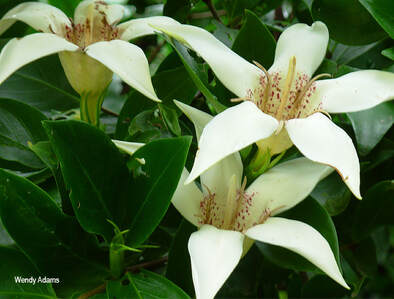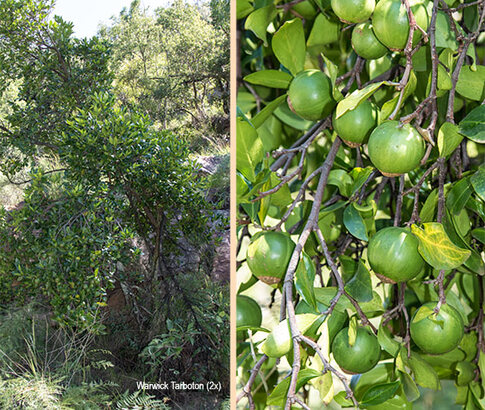|
Rothmannia capensis (witklokke) is a small or medium tree occurring in the forest or on Rocky Hillsides in bushveld. The tree is of the family, Rubiaceae (the coffee family), states Van Wyk (2013). “The reason I love this tree is because of its growth form and the way it grows very straight. The flowers are also beautiful, and the tree is very thick. I find its shade of green absolutely glorious” says Oom Twakkie. Oom Twakkie (Goliath Highburg) is our quality controller and our "go-to" person for species identification. He calls this tree katjiepiering or wild gardenia which are some of its common names. “The gorgeous flowers almost look like the ones from a granadilla bush” adds Ricardo, our project manager. Rothmannia capensis is usually distributed from Limpopo in the North to the Western Cape. It is found in forest, kloofs and on rocky edges from sea level up to about 1600 m. The flowers are white with maroon strips inside the throat of the corolla tube, fading to cream with green fruit that is about 70 mm in diameter (Van Wyk., 2013). The flowers have a strong scent and are extremely attractive to the eye. The plant is called omkhulu in the Zulu tradition (Kelmanson et.al, 2000).The juice from it can be rubbed on burns and wounds to help them heal. Interestingly, the wounded parts of burns can be held in the smoke of burning roots. Baboons eat the green, ripe, fruits from the trees, while bushbuck and bush pigs eat the fruit that falls off the trees. The tree also attracts birds, and it acts as a nice garden tree. The wood of the tree is hard and strong and suitable for making implementing instrument handles (Sanbi and Van Wyk .2013). The wood can also be used to make strong spoons for cooking and porridge sticks and the dry wood is used for fire.
The tree grows well in light shade or full sun and is simple to grow from the seed. It grows in loamy soil. You can take out the seed from the brown fruit and spread them in a mix of 3 parts river sand to 1 part compost. Keep the seed mix moist until germination, which is generally 14 days. There are several Rothmania species but when I see them, I am always hoping to see this specific one in the indigenous forest. According to Oom Twakkie, the last time he saw it was in February, but he is hoping to see it again soon. He smiles when he says that the wild gardenia tree is found quite commonly in the conservancy forests. As a newcomer to the area, I have not yet had a chance to see this lovely tree but I’m now on a hunt to see Oom Twakkie’s favourite tree in our special forest. What’s your favourite indigenous tree? Leave a comment below and share your favourite tree and why. References http://pza.sanbi.org/rothmannia-capensis Kelmanson, J.E., Jäger, A.K. and van Staden, J., 2000. Zulu medicinal plants with antibacterial activity. Journal of Ethnopharmacology, 69(3), pp.241-246. Van Wyk, B., 2013. Field guide to trees of southern Africa. Penguin Random House South Africa.
0 Comments
|
AuthorGVB Conservancy Staff Archives
May 2024
Categories |


 RSS Feed
RSS Feed






